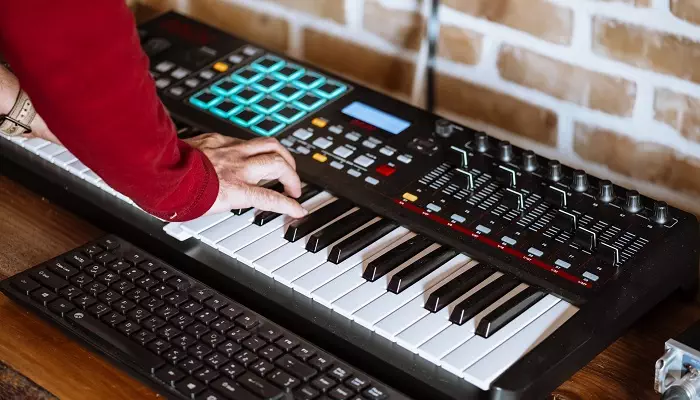What is Music? Definition, History, Types, Effects & Examples
There’s music in everything; our bodies, the movement of the planets and stars in the galaxy, the communication between people and animals, as well as the movement of wind and water.
Leonard Bernstein says, “Music can name the unnameable and communicate the unknowable.” It’s the universal language that people can use when words fall short of conveying the meaning.
So, what is music? How has music influenced humanity throughout history? This article will tell you everything you need to know about music.
So keep on reading to learn more about this topic. Table of Contents Show
Table of Contents Show
What is Music?
In short, music is the art of combining and organizing sounds along with other elements in time to create a composition. It incorporates elements of rhythm, melody, harmony, and color to create a unique piece.
Music includes other elements like the pitch, which controls the melody and harmony, and the dynamics that affect its texture.
It’s one of humanity’s cultural aspects, usually used by humans to express emotions, statuses, events, and stories.
There are numerous types and music genres that either focus on or neglect these elements to create a new style with distinctive characteristics.
Music is performed using various musical instruments that can be incorporated with multiple vocal techniques.
Elements of Music
Some elements of music are fundamental, while others are less important and not that widely used.
The most fundamental elements include the style, dynamics, pitch, beat, tempo, rhythm, melody, harmony, vocal allocation, color, expression, articulation, form, and structure.
In some definitions, some of these elements aren’t considered fundamental. For example, British musicians add musical notations to these elements and ignore the presence of other elements like harmony and melody.
Pitch and MelodyThe pitch refers to how high or low the sound is. This can refer to melodies, basslines, chords, and vocals.
The melody is the tune that is made of a series of pitches or notes played in succession. The notes are played following a system or scale.
Folk music songs usually use notes from a single scale. Other genres like Freestyle Jazz and Bebop Jazz incorporate more notes from several scales.
Harmony and Chords
Harmony is made of 2 more notes played at the same time. The chord is made of 3 or more notes, so chords make up harmony. More complicated pieces from Classical and Jazz music have more than one home note.
Rhythm
This refers to the art of arranging sounds and silence periods in time, while grouping notes in measures or bars. In Western music, rhythm is defined in sets of 2, 3, or 4 notes.
Texture
This is the overall sound of a music piece or song and is determined by how other elements are combined.
Music pieces that have a thick texture feature many layers of instruments. The texture is also affected by the intensity of the sounds. Music texture can be divided into monophony, heterophony, or polyphony.
Color
 Color or timbre is the quality of the sound of the instrument or voice. The timbre differs according to the instrument used to play the note and the technique of the musician playing it.
Color or timbre is the quality of the sound of the instrument or voice. The timbre differs according to the instrument used to play the note and the technique of the musician playing it.
Electronic instruments like the electric guitar and electric piano allow performers to change the tone by adjusting a few controls or adding electric effects.
With traditional instruments, the instrument’s material and the performer’s technique will add these effects.
Expression
The expression doesn’t change the notes but adds more quality to them. Performers can add expression to melodies by stressing words or adding vibrato to specific notes.
Style
The style of the music refers to the elements upon which more weight is put. Rock music puts more emphasis on the craftsmanship of the performer, so it’s usually performed in live concerts.
Funk puts more weight on the rhythm and groove, while Jazz puts more emphasis on complex chords that change several times in a tune.
Metal music puts more weight on fast guitar solos and anthemic choruses. Rappers and Hip Hop performers focus on the flow of music and lyrics. The performers are able to deliver words fast without getting tongue-tied.
Purpose of Playing Music
 Music is played for various purposes, including religious, ceremonial, aesthetic pleasure, or entertainment purposes.
Music is played for various purposes, including religious, ceremonial, aesthetic pleasure, or entertainment purposes.
In the past, music performances were exclusive to churches, temples, and courts of royalties. Some religious practices involve the creation and performances of music pieces.
During the Classical era, music was directly related to a higher cultural and socioeconomic status. People learned to compose and perform music to become members of the elite community in Medieval Europe.
As a result, people tried to get music sheets to perform their favorite music pieces at home. Later on, the phonograph made records of popular songs more available and accessible.
The invention of the tape recorder and digital devices allowed people to create customized playlists of their favorite music genre. Music became a crucial component of other entertainment performance arts as movies and theatre plays.
Amateur musicians can compose, perform, or teach music for their own pleasure. Professional musicians are employed by institutions, organizations, or even work as freelancers.
Music is considered the main source of income for millions of people who currently work in the music industry.
Music Composition
 Music composition is the process of creating a music piece or a song.
Music composition is the process of creating a music piece or a song.
In most Western music genres, the process of creating music also involves the creation of music notation, which the performers follow. In some genres, the performers rely on improvisation.
In Classical music, the composer does the orchestration, but in other genres like Pop music, an arranger does this job.
Some of the world’s lead Jazz, Pop, and Rock musicians don’t use notation and usually compose and play their music from memory.
Because in some cases, the notation doesn’t specify all the elements of the music, the performer has some freedom to play or interpret the music according to their taste and vision.
The same music work can be differently interpreted by changing the tempo or playing style to create a unique piece.
Musical composition is usually the work of one artist but can also represent a collaboration of several composers.
This is more common in modern music genres like Metal and Blues, where one band member writes the melodies while another writes the lyrics.
In Avant-Garde and experimental genres of music, the computer adds digital effects to contribute to the process of music composition.
Music Notation
 Music notation is using sheet music as a written representation of melodies using symbols. It also provides instructions on how the music should be performed by setting the tempo and genre.
Music notation is using sheet music as a written representation of melodies using symbols. It also provides instructions on how the music should be performed by setting the tempo and genre.
First, notations were hand copied. The printing press made printed music easier to obtain. Nowadays, computer score writer programs are used to create music sheets.
In most music genres, the score is a comprehensive music notation that allows all the individual performers to work together on an ensemble piece. In Pop music, the notation is the lead sheet that states the melody, chords, and lyrics.
In Jazz music, musicians usually use several simple chord charts, which allow the rhythm section members to improvise.
Improvisation
Improvisation is the art of creating spontaneous music that is played within a pre-existing harmonic or chord progression. It’s one of the main elements of several genres, including Jazz, Rock’n’roll, Blues, and Metal.
Performers add ornaments and use tones that aren’t from the same scale. In Pre-Classical music, performers usually improvised ornaments, while soloists improvised preludes to their performances.
In more modern genres, most details were listed in the musical notation, leaving little room for improvisation. After the Classical period, some genres allowed for more improvisation, which played the evolution of genres like Hip Hop and R&B.
Musical Performance
 The musical performance is the physical expression of the music, which occurs when the melodies are played by an instrument or a song is sung. The musical performance focuses on the interpretation by the performing artist.
The musical performance is the physical expression of the music, which occurs when the melodies are played by an instrument or a song is sung. The musical performance focuses on the interpretation by the performing artist.
Cover songs are an example of interpretation in modern genres like Metal and Jazz. The performing artist or band can add an instrument, change the intro of the song, or change the orchestration to change the whole genre of the original piece.
Ornaments are made of added notes to decorate melodies. The details vary between genres and musical eras.
During the Baroque period, performers learned to add simple ornaments to make music more unique. Composers didn’t describe in detail how a music piece should be played, allowing the performer to express the music individually.
In Classical music, the performance was usually rehearsed, and the rehearsal was led by the conductor. Interpretation is less common in the Classical music genre.
In Rock, Blues, R&B, and Jazz performances, the performers usually improvise based on the pre-existing chord progression. The music piece still maintains its original structure but might sound different every time it’s played.
Many genres like Blues were originally memorized by the performers and not written in music sheets. They were either handed down orally or aurally.
Once the name of the composer is no longer remembered or known, the piece is usually classified as folk or traditional music.
Folk music was used to pass on the history of a culture or a community. This is clear in genres like Blues, Jazz, and Country music.
The expressiveness of the music involved the use of tempo and pauses to make music more appealing. In the 20th century, music notation became more specific, and composers specify how the performer should play or sing the piece.
Other genres like Heavy Metal and Hip Hop involved the extensive use of ornaments, especially during live performances. In Pop music solos, some performers recreate a famous version of other solos.




















































